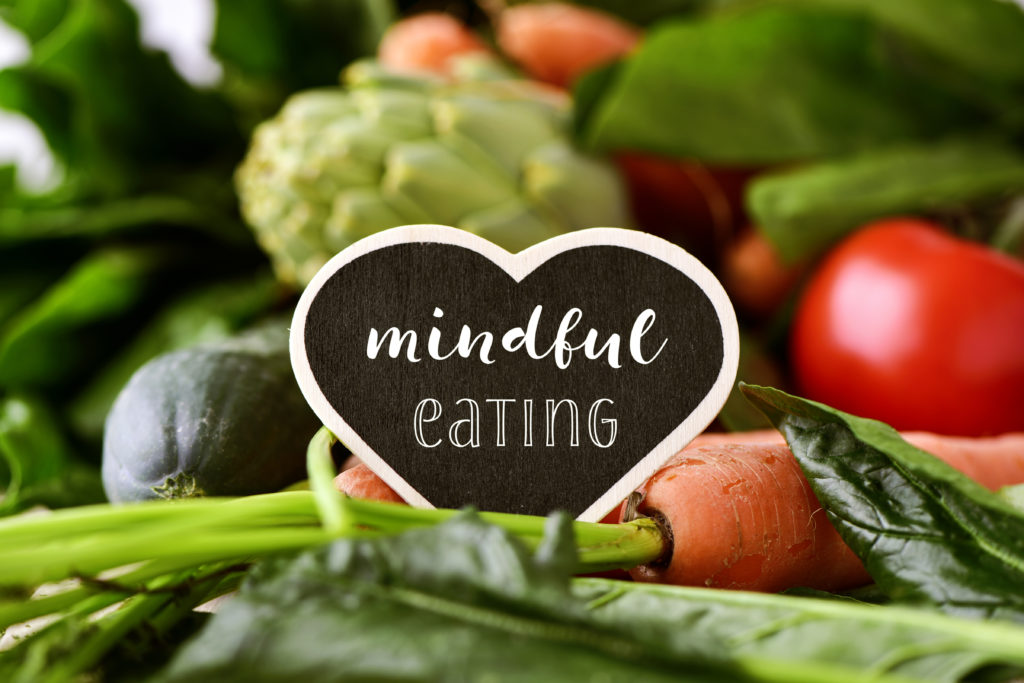
What Does “Mindful Eating” or “Intuitive Eating” Mean?
The two terms are often used interchangeably, but they mean different things. Mindful eating is the process of paying attention to your actual eating experience without judgement. This sounds simple and straightforward, but the process can be complex, especially for those who are not used to it. A mindful eating practice helps you become aware of the reasons behind your hunger (emotions, lack of food, tradition, schedule, etc.).
Intuitive eating is a broader philosophy that incorporates mindful eating. It emphasizes attunement of mind, body, and food, and focuses on strengthening the relationship with all three of those elements. This approach includes using nutrition information without judgement and respecting your body regardless of how you feel about its shape.
According to Evelyn Tribole, MS, RD, those who practice intuitive eating
- Eat for physical reasons, rather than emotional reasons
- Rely on internal hunger and satiety cues to guide when, what, and how much they eat
- Give themselves unconditional permission to eat
Mindful and intuitive eating practices are helpful for everyone, but they are especially important for those who have suffered from disordered eating patterns, or who feel like food controls their life. They provide a respectful and healthy way to reconnect with food while gaining a deeper understanding of your mind and body.
Mindful and intuitive eating practices are not diets. They are mindsets that require you to trust your natural instincts and listen to your body’s natural hunger and fullness cues. In these practices, there is no room for outside influences like social pressures to eat or not eat certain foods. There is no directive to eat or not eat specific amounts of food at specific times. Instead, these practices teach you to listen to how your body is feeling and allow you to make food choices for yourself without judgement.
Getting Started
Mindfulness is a struggle for many people, and it takes time and dedication to master. Work your way up to eating mindfully every day and forgive yourself when you don’t. Being aware that you don’t always have the time or energy to eat mindfully is part of building a successful mindful eating practice. Trust your instincts, and your body’s instincts. It can take weeks, months, and sometimes years for mindful or intuitive eating to become a natural part of your life. Be patient with yourself and enjoy the process of building a stronger mind-body connection and improving your relationship to food.
Tips for Eating Mindfully and Intuitively
- Prepare. Cooking for yourself is the best way to prepare your body to eat mindfully. When you are preparing food, the sights and smells ignite the part of your brain that readies your body to accept nourishment. If you are eating at a restaurant, enjoy the sounds, smells, and sights as you wait for your food.
- Put away electronics. Allow yourself to hold space for one thing: eating. Make sure all electronics are away from your eating space and eyesight.
- Sit down. Take a deep breath, center yourself, and give yourself permission to eat as much as you want and enjoy the food in front of you. If desired, this would be the time to give thanks, pray, or say grace. Express gratitude for all of the people who had a hand in growing and making your food, including yourself.
- Develop a mealtime ritual. This may include setting the table or turning on some relaxing music to enjoy during the meal.
- Be still. Dedicate at least part of the meal to silent enjoyment of the food.
- Connect. When eating alone, connect to your mind and body. Note to yourself how the food tastes when you chew slowly and savor it. Pay attention to your body’s reaction. When eating a meal with family or friends, connect with them over the meal. Talk about the food together.
- Take in the food with all of your senses. What does the food look like? Is it appealing, or unappealing? What do you hear? Is the food sizzling? Is the music you chose relaxing? What does the food smell like? Are there smells other than the food? How does the food feel in your hands or in your mouth? What’s the texture like? How does the food taste? Is it savory, or sweet? Taste everything and chew slowly. Try to identify ingredients and flavors. This activity can be helpful for anyone looking to heal their relationship to food. It can be an especially fun activity with children to help them understand and appreciate what they are eating.
- Listen to your body. Recognize when you have had enough to eat, or when you want more. Honor those internal cues as natural and healthy. A major sign of fullness is that food becomes less appetizing or doesn’t taste as good as it did when you began the meal. Note that internal regulations can be disrupted for certain people, particularly those with eating disorders and diabetes. Significant intake of sugar and processed foods can also disrupt the body’s natural fullness cues. If you find yourself eating uncontrollably, you may need to limit the amount of food you put on your plate at first. Waiting five minutes before getting seconds can also help your body become more attuned to hunger and fullness cues.
- Reject the dieting mindset. Do not attempt to restrict your intake of foods or significantly limit calories. Don’t punish your body for craving foods that others might deem as “bad” or “unhealthy”. Let go of the notion that your body must conform to societal standards of beauty. All bodies are worthy of love and life. Shift your focus away from actions you think will change the way your body looks. Instead, focus on actions that will improve the way your body feels.
References
Bacon L. Health at every size the surprising truth about your weight. Dallas, TX: BenBella Books; 2010.
Bacon L, Aphramor L. Body respect: what conventional health books get wrong, leave out, and just plain fail to understand about weight. Dallas, TX: BenBella Books; 2014.
David M. Nourishing wisdom: a mind/body approach to nutrition and well-being.
New York: Bell Tower; 1991. n The Center for Mindful Eating – Home. The Center for Mindful Eating – Home. http://thecenterformindfuleating.org/. Accessed March 4, 2017.
Tribole E, Resch E. Intuitive eating. New York: St. Martin’s Griffin; 2012.
